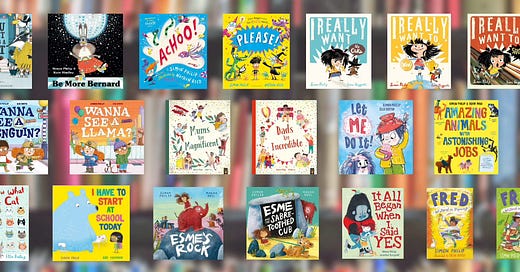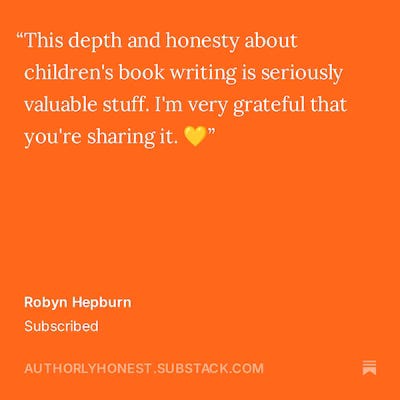FAQ Friday #9: How do you choose who illustrates your book?
Dispelling some common misconceptions
Happy Friday, everyone.
It’s been a loooong time since I published anything in my FAQ Fridays series, in which I answer the questions that I’m frequently asked. These are the questions asked by kids, teachers and librarians when I visit schools and do events, and by people generally when they discover – because I ram the fact down their throat – that I’m a children’s author.
Having started out posting weekly FAQ Fridays, in December I said I would be publishing them monthly instead, simply because posting as often as I had been meant that I was spending far too much time writing for Substack and far too little time writing manuscripts. Then, in the six months that followed, I failed to post a single one…until now!
In case you’re not familiar with this series – which is more than likely, given its absence – here are the frequently-asked questions that I’ve answered thus far:
Why (and how) did you become a children’s author?
How do you handle moments when inspiration seems hard to find?
Where do you get your ideas from?
How many stories have you written?
What are the best bits and the hardest bits about creating children’s books?
How can I encourage my child to read – and do you have any tips for reading with them?
How do you come up with the titles of your books?
Now, on to today’s question…
How do you choose who illustrates your book?
This is an easy one to answer.
And the answer is: I don’t.
It’s common for those outside the publishing industry to assume that picture book manuscripts are submitted to publishers complete with finished illustrations, and that the author, if they’re not also the illustrator, is responsible for finding an illustrator for their text.
The vast number of posts on writing forums along the lines of ‘I’ve written a children’s book. How do I find an illustrator?’ indicates that many new picture-book authors wanting to query agents also have a similar misconception. And also, perhaps, that the vast majority of people assume that creating children’s books is ridiculously fucking easy child’s play a doddle.
(A caveat here: I’m talking solely about traditional publishing. Self-publishing is totally different, and, generally, an author wanting to self-publish would need to find an illustrator themselves.)
But the reality is that publishers almost always prefer to find their own illustrators for the books they plan to publish. There are many reasons for this.
Some are strategic: for instance, if a publisher deemed a text to have great Rights potential, they’d want to choose an illustrator whose stye also has international appeal. Or a publisher may pair a debut or emerging author with a more established illustrator in order to raise the book’s profile and sales potential (and vice versa, of course).
Others relate to timing, and scheduling: is the publisher’s first-choice illustrator available to work on the text, or will they have to wait too long for a slot to become free in that illustrator’s schedule?
But perhaps the most obvious reason publishers want to be able to choose their own illustrator for a manuscript is because it enables them to ensure a good match between the tone of the text and the style of the artwork, avoiding a situation whereby they like one or the other, but not both together, i.e. they love the manuscript, but hate the accompanying art (or the other way round).
Establishing the right author-illustrator pairing – and matching an illustrator’s style to an author’s ‘voice’ – can be crucial to the success of a book, and involves a great deal of creative vision and skill. I’d argue that editors, designers and art directors are much better placed to do this than authors themselves are.
Although I know which styles of illustration I like upon seeing them, and am able to think visually to a certain degree – which is necessary in order to write good picture book texts – I can’t do so to the extent that I could pick my own illustrators and have complete confidence that the match would work.
And, if I were able to pick, I’d probably select the highest-profile, best-selling one, to be honest (I’m trying to make a living, after all…).
However, publishing teams can match authors and illustrators well: they know not just how to interpret a manuscript, but also which illustrators are likely to share their interpretation and vision for it.
This article from Penguin on how to become a book illustrator provides some great insight into how illustrators are chosen for particular projects, so do give it a read if you want to know more about that… and if you’re reading this as an illustrator, I’d love to know YOUR experience – so please do comment below!
So, with that question answered fairly simply, here’s another one..
Does an author get any say in who illustrates their book?
My answer to this one is: sort of.
Generally, editors will, at the very least, inform the author of which illustrator they have in mind for their text, sometimes before it goes to acquisitions (if they’re really confident of getting it through), but usually after it’s been signed.
Sometimes this information will be conveyed in a manner which suggests there’s room for the author to voice whether or not they’re on board with the publisher’s choice.
Would the publisher actually find a different illustrator were the author to suggest one? I just don’t know, as I’ve never done that - although I have been asked by editors which illustrators I like, and have sent them a list of names.
Sometimes, the publisher’s proposal will be accompanied by sample character sketches from the illustrator, on which the author will be invited to comment.
I suspect, however, that in the majority of cases, the publisher’s ‘suggestion’ is, in reality, a decision, and that they’d be unlikely to change it without very, very good reasons – because they would have very, very good reasons for proposing that particular illustrator.
Of course, there’s bound to be some cases in which the normal ‘rules’ don’t apply, and it’s not implausible that suggestions or even demands from authors who are consistently at the very, very top of the best-seller charts may hold some sway with their publishers.
It’s also common for people outside the industry to think that the author and illustrator of a book meet regularly in person to shape its creation.
Typically, this is not the case – although, again, exceptions will exist: very well-established author-illustrator partnerships may frequently come up with ideas together, and keep in regular contact whilst the book is being made.
Generally, though, someone at the publisher acts as the intermediary during the process – editors with authors, and designers and/or art directors (and sometimes editors) with illustrators. Agents may also get involved if particularly tricky problems arise.
It’s normal for the author and illustrator of a book not to meet during its creation.
I’ve had the pleasure of working with 13 brilliant illustrators (that’s all the illustrators I’ve worked with, by the way – I wasn’t going to add ‘and 4 appalling ones’)…
…seven of whom I’ve met. But I’ve met only one of those seven during the creation of a book, to discuss it.
Thankfully, it’s also normal (at least in my experience) for publishers to update authors on how the illustrator’s artwork is progressing, through sharing their work at the various stages: sample sketches, black and white roughs, the first few colour spreads, final colour artwork and the cover.
For me, getting to see a story’s artwork for the first time is undoubtedly one of the best and most exciting aspects of being an author. And from that point on, the process can be quite collaborative (although rarely directly with the illustrator).
As the process of creating the book develops, tweaks to the text or illustrations often need to be made, and so publishers genuinely want an author’s input. I’ll also comment if I think something isn’t quite working in the illustrations if it’s important to the story – for example, if something crucial to the plot or a joke is absent from the illustrations, or if the interplay between the text and the pictures is confusing (though that rarely happens).
Usually, though, I simply comment on how much I love the artwork, because, more often that not, I genuinely do.
I’m a bit in awe of illustrators and what they can do, and I’m very grateful that they’re able to bring my words to life, and make my writing appear way funnier and more accomplished than it probably is. I wouldn’t have a career without them!






